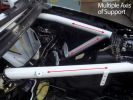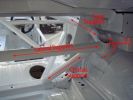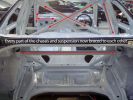By Thorney Motorsport – Mon, 11 Jan 2010 16:28
We seem to have more phone calls and questions on cages andtheir fitting than anything else these days, be them for full race carpreparation or just track day use there does appear to be a lot of misunderstandingabout what a cage is designed to do it seems. In simple terms there are two kinds of cages for cars – a safety cageand a chassis cage. A safety cage is exactly as it sounds, a cage installedinto the car to protect the occupants in the event of a crash, its purpose issimply to prevent the occupants getting squashed in the event of a side impactor worse still a roll over. Pretty much all bolt in cages are safety cages. Theother kind, a chassis cage, is where the whole chassis is essentially tightenedup and strengthened effectively making parts of the bodywork simply there forshow; the whole car is stiffened up around the design of the cage. This is whatwe do.
Designing cages is part art, part experience and partscience, the overall aim is to connect up the whole chassis to one controllableframe where flex and lack of flex and movement can be predicted, controlled andtaken advantage of to improve grip and handling. All road cars have flexdesigned into the chassis, sometimes deliberately (flex = more comfortable ridein some case) and sometimes as a necessity of design (big holes in the framefor doors, sun roof etc) so the one constant when designing a cage is toincrease the overall chassis stiffness. One crucial aspect is to stiffen thechassis at the suspension points, by limiting flex here the cars suspension canbe isolated from external movement and a ‘pure’ suspension set up be developed,whilst road car chassis tend to be quite stiff at the suspension points theextra stress that full race suspension (especially on slicks) is such that itis here that we can make the most gains.
Here pictures paint a thousand words so in picture one youcan see the intricate design the cage makes up, the front suspension towers(where the front suspension bolts to the cars chassis) have the white cage barsextending from the main cage and the main cage in the cabin forms a multiplerole of both protecting the occupants in the event of a roll over but also tiestogether all aspects of the chassis to each other.
Picture 2 shows more detail of the front suspension tower.Front suspension legs are a key area of both lateral and longitudinal flex,they literally stick out from the shell with the engine mounted between them soit is imperative to tie these into the chassis otherwise the whole front end ofthe car will feel loose and disjointed from the back, especially under braking.On road cars this is why a lot of performance cars have strut braces where abar of metal is bolted from the top of one suspension tower to another, mostrace cars (where the cages have been extended far enough) don’t need them. Thepicture shows how we support the suspension on three separate axes, from thecentre, the side and underneath. Picture 3 more clearly shows the two sides wherethe cage is welded to the suspension tower, underneath the suspension point isre-enforced so in effect the front suspension is actually attached both to thecage and the chassis rail together.
Moving back from the front of the car the next area for considerationis the A pillar/windscreen and passenger safety cell. Picture 4 shows the A pillar design, the cagecomes across from side to side (known as the dash bar), from the frontsuspension support (one three axes) and forms part of the side and roll overprotection, bar A, B and C are both side impact and form part of the roof bar,strength in this area is important as it protects the occupants legs in theside of a side or three/quarter impact – common in racing. If you see in thispicture of the E46 M3 crash we suffered even though the impact was over 60mphsideways into a concrete wall the drivers leg area was completely unaffected.
With the relative high weight and size of the E92 chassiswe’ve designed the side impact protection to be as low as possible to keep thecentre of gravity as low as we can, it also makes the car easier to get in andout of, for regulations purposes there is a set time limit of ten seconds toget out, if it takes any more then it in theory is illegal, mind you, if thecar is on fire its a pretty good incentive for even the most immobile driver toget out pretty damn quick!
A lot of the main design work goes into the main chassispart of the cage, here the driver needs to be protected by the roof bars, aroll over hoop which passes under the B pillar section of the car and then allconnect up to the rear suspension towers. At the same time we need to ensurethat there is room for a larger capacity fuel tank (the car has been designed forsprint and endurance racing where a 110 litre tank is needed), provision forharness mounts for the driver and passenger (this car will be used for demorides for passengers) and of course strengthening and supporting the chassisand in our case air jack points.
 Picture 5 shows how all these parts interlink, A is the rollover cross brace protection, B ties the rear suspension towers and supports tothe main front hoop of the cage, C ties the suspension towers to the chassisfloor, D ties the chassis floor to the main B pillar hoop and E is the harnesssupport mounted as close as possible to the seat to avoid harness flex (moreimportant now with Hans devices compulsory in a lot of race series). Theimportant feature is that every part of the chassis is literally tied to eachother, this creates both a very stiff platform but also creates structuralconnection that we can exploit when setting the car up – the whole car reactsas one rather than several disconnected flexible points.
Picture 5 shows how all these parts interlink, A is the rollover cross brace protection, B ties the rear suspension towers and supports tothe main front hoop of the cage, C ties the suspension towers to the chassisfloor, D ties the chassis floor to the main B pillar hoop and E is the harnesssupport mounted as close as possible to the seat to avoid harness flex (moreimportant now with Hans devices compulsory in a lot of race series). Theimportant feature is that every part of the chassis is literally tied to eachother, this creates both a very stiff platform but also creates structuralconnection that we can exploit when setting the car up – the whole car reactsas one rather than several disconnected flexible points.
Picture 6 is taken from the boot, here you can see in detailhow we build up the rear suspension chassis points, weld in extra strengthening(some inside the tower where you cant see) then ensure that the whole are issupported again on three different axes, the suspension is now mounted to thechassis and the cage which is connected to the chassis itself to the floor, theside and the cage. Picture 8 shows the same area from a different angle andalso shows part of the fire wall which we need to install – this is to separatethe remotely adjustable suspension (which are high pressure gas filled) fromthe driver section, another regulation.
Picture 7 shows the cage from the rear, the symmetry isperfect.
 Once the cage is in we need to paint it, very thin,lightweight paint is used with a single cover and one of laquer, we want it tolook nice but extra paint means extra weight – not needed, whilst white is apain to keep clean its a traditional BMW colour and we like to keep sometraditions and you’re done. Next up is putting it all back together.
Once the cage is in we need to paint it, very thin,lightweight paint is used with a single cover and one of laquer, we want it tolook nice but extra paint means extra weight – not needed, whilst white is apain to keep clean its a traditional BMW colour and we like to keep sometraditions and you’re done. Next up is putting it all back together.
Cages, Harnesses, and the LAW. Contrary to popular belief itis not illegal to have a cage in road car, even one of these silly ‘cosmetic’cages made of shiny polished aluminium (which are lethal in the event of acrash as the aluminium conveniently folds itself into knife shapes when itdeforms). However the design needs to ensure that the occupants wont come intocontact with the cage in the event of a crash – not as simple as it sounds ifyou keep using the standard static seat belt as they allow the body to move alot more than race harness. This means at least 6 inches of clearance from yourhead. Using harness in a road car is also not illegal but technically the beltrelease button must be a push button type not an aircraft type to pass an MOT,this is to ensure that ambulance, fire service and police know what to do torelease you, for some reason the DOT thinks all first responders are thick, gofigure. Typically on a road car we tend to advise owners to keep the static beltfor the road and a harness for the track, the reason being that race harnessonly work when they are tight and I mean tight, as in hard to breath in fully,a race harness worn loosely will simply snap your collar bones in the event ofa front impact, these then fold in two resulting in your head hitting thesteering wheel – unpleasant. So, do it right and you’re fine, do it wrong andat best the police will nick you and at worse you’ll get killed so be careful.
Attached Images:



Thorney Motorsport on Facebook

